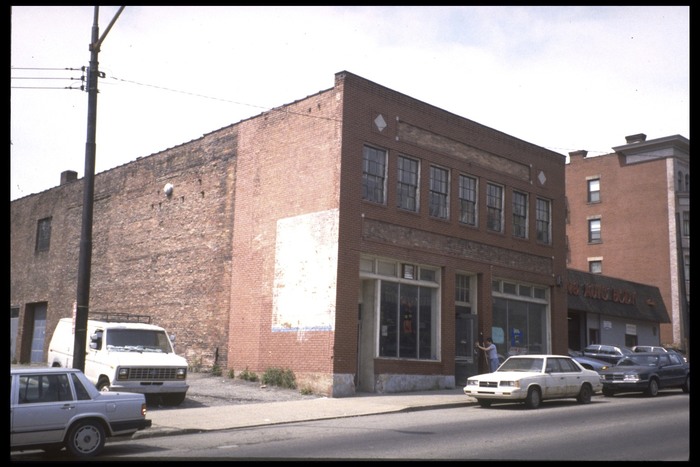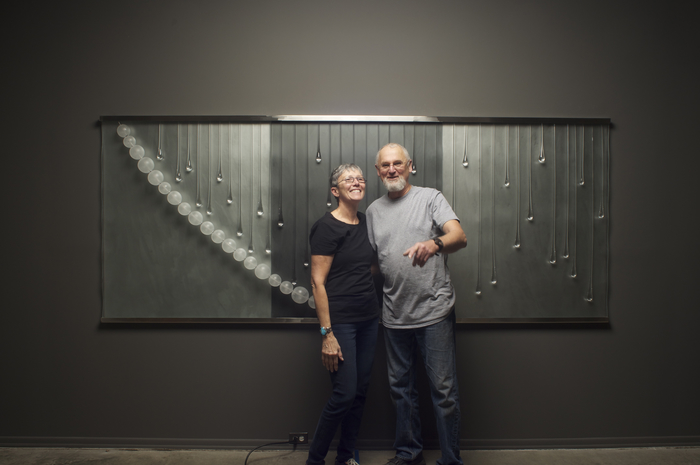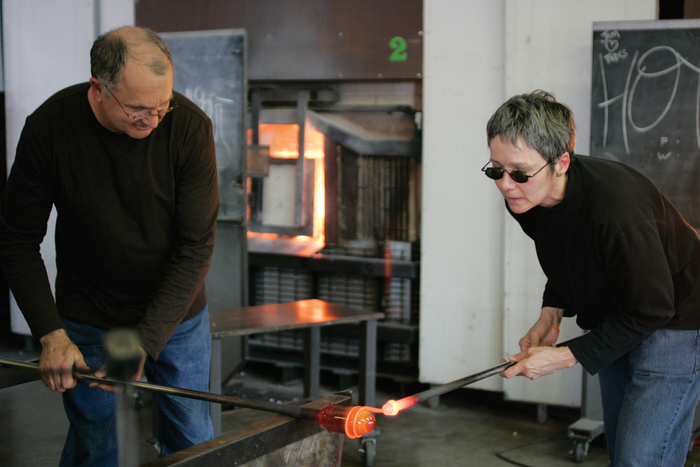
HOW WE MADE THE PITTSBURGH GLASS CENTER
Pittsburgh has changed.
The city I first came to in 1976 was insular, exclusive, and without street signs to tell you where you were going, because everyone seemed to be from here and knew where to go!
I was lost many times that first year!
Artists can make a huge difference in the life of a community, a city, a region, a world.
Maybe coming from the “outside” made us keenly aware of what was “missing and of course no one wanted to hear it at first. We would often hear a familiar refrain of “what is so wrong with Pittsburgh”. When I would mention a program going on in other cities, it was like time stood still here. Everyone was content in their sections of town, until the steel mills started to fail and many lost their homes, income, and lives in the balance because they believed things would just go on as they had done for the past century and the mills would come back. It was temporary.
Pittsburgh needed to reinvent itself. And thank goodness the foundation community that held so much wealth from a very generous philanthropic few knew that too!
In some way it was pivotal to leave teaching at CMU in 1989. It was tough believe me but it also had that same insular quality. As a professor we were addressing a small segment of the population of 18-21 year olds. Almost everyone left Pittsburgh so they added little to the cultural or artist life of the community. How could they? There were so few galleries to show and sell work. Carnegie Mellon purchased one of the best ones – The Pittsburgh Plan for Art - on Craig Street and turned it into offices for their expansion. So by the late 80’s there were less showing opportunities and getting smaller.
Pittsburgh also suffered from an intense lack of resources for artists, creative people and the general public. And I don’t mean a room to hold Saturday painting classes where you brought your canvas and paints to class – but something real- something with excellent equipment, state of the art, kilns, tools, to make things. Without these we are left with little to move us forward.
Before I left teaching we had to build our own studios at our home in Oakdale. Ron and I had built our house first, on a barren piece of land, yes we did it, not a contractor. We built kilns for the 10th time between us. Ron came from a clay background and set up several studios with kilns, I came from undergrad at Kean University in NJ where we built the first, to Alfred building large furnaces, to Bowling Green, to Carnegie Mellon where we built a super shop. But in the end CMU didn’t want the glass studio going the way of the Pittsburgh Plan for Art, that it was expendable, wasn’t cost effective etc. I was an untenured faculty so easily tossed for a computer lab.
I had written grants while at CMU to bring nationally known artists to work for a week at a time in our studios. Classes would participate. It was exciting to see such an elite group of artists in action like Dale Chihuly, Albert Paley, Paul Marioni, Wendy Muryama etc.
Later we created an art program for the town of Carnegie of benches and planters designed and built by artists. This one project gave them the distinction of being named one of the 100 small art towns in the country.
David Stephens of the PCA contacted us first in 1990. Then, the Mon Valley Initiative visited in 1991 asking us to think of creating an art center and we thought Glass Center for the Pittsburgh Region. Ron and I spent the next 17 years imagining, visioning, building, selecting every piece of equipment, artists to teach and creating exhibitions, every class curriculum, to furniture, exhaust systems and most important to the building, reusing resources such reusing the heat that came off the furnaces to heat hot water and for heating in the building to being on a bus line, in an blighted community.
We heard a lot of apologies for Pittsburgh in the beginning. Who would come here? Why such good resources in such a poor neighborhood? We wanted people to cross the unseen lines of race we live with everyday and meet each other in the spirit of creativity.
We wanted to encourage and promote glass art throughout the region and nationally. We dared to think on a grand scale.
In the beginning we were told by a local ED of a craft organization that our project though interesting did not fit the pie. She made the shape with her hands. And I thought, is that so.? I asked another local arts ED about an artist house we intended to purchase for the glass center so artists from around the world would have a place to live right next to the glass center and he said that was ridiculous, why do we need places for artists to stay.? Another arts foundation advisor said, who will come here to work in glass, you are the only 2 artists recognized in the region.? Why would they come here? It could make anyone doubt but I had seen the success in other cities.
This is what we have accomplished over the past 10 years.
PGC has reached more than 100,000 participants through its classes, programs and community outreach since it opened to the public in October 2001.
15,000 students have taken classes from internationally renowned glass artists such as Walter Lieberman, Dante Marioni, Benjamin Moore, Stephen Rolfe Powell, Davide Salvadore, Susan Taylor Glasgow, Cesare Toffolo, Gianni Toso, and Karen Willenbrink among many others.
In total over 280 artists from around the world have come to PGC to teach in the last twelve years.
In the year of Glass 2007, when the glass center hosted an international conference on Glass Art, we brought together organizations such as Phipps and the Carnegie Museum of Art and created a massive installation downtown with Therman Statom’s work, hosted an international Japanese artists exhibition and created a unique school programming around this with internationally recognized artists teaching youth. This year of Glass brought in $20 million in revenue to Pittsburgh through all program surrounding this unique conference.
PGC is a school, gallery and state-of-the-art green glass studio, one of only a few public access glass art centers in the U.S. World-renowned glass artists come here to make studio glass art. People interested in learning more about glass come here from all over the world to take a class, explore the contemporary glass gallery and watch live hot glass demonstrations.
One of the top glass art facilities in the United States, PGC is a “Green Building” with state of the art ventilation in all shops and heat recovery from the furnaces. Building elements such as garage doors, glass paneling and exposed brick are not only recycled elements, but also give PGC its unique urban/industrial edge. The building has been redesigned in accordance with federal Leadership in Energy and Environmental Design (LEED) standards and is LEED Gold Certified.
PGC is also the largest arts organization on Penn Avenue in Pittsburgh’s East End and is a cornerstone of the Penn Avenue Arts Initiative, a collaborative community effort to revitalize this East End corridor through arts-related programs. By making its home in this location, PGC is an anchor tenant for the arts initiative and provides support to the efforts of neighboring arts groups, youth programs, social service agencies and community development initiatives. The area is rapidly becoming a vibrant arts district.
PGC is also totally unique to the region. Even among other arts organizations we have been called “a pineapple among apples and oranges.” Our contribution to a healthy arts environment is bringing diversity to the ecology – we are like nothing else that exists in southwestern Pennsylvania. We are a unique blend between visual art and performance art.
Through the help boosters like Bill Block Sr. who smoothed the our path to the very generous foundation like Hillman Foundation with Ron Wertz, Heinz with Mary Navarro, McCune Foundation and Jim MacDonald at Mellon Bank, RK Mellon and on, “the greater we” built this. For Ron and I it was missionary work. We used our money, credit cards, our frequent flyer miles and our time in the service of others. You couldn’t ask others outside of a fantastic board of directors to volunteer their time. Their generosity, their sense of service to others, was much appreciated for the building, and for us. They buoyed us, encouraged us, fed us, helped us, advised us and we became lifelong friends as we did with those in the foundation community who gave so willingly to this life changing, city transforming project.
My advice is cherish each other, there is so much you can do together, make a place for art and artists in your hearts and in your life. Your world will be better for it.

The Audacity to Create Something New
The Pittsburgh Glass Center 1992-2009
It is seldom easy to convince potential funders and supporters of something so new to the region that it will tip the balance of all other things if it is put in place. But, when the idea that starts as a seed in the mind grows and manifests itself in supporting documents, feasibility studies. comparative analysis and case for support, then at least for the “Instigator” there is no stopping until the thing is achieved or there is a resounding “no” in every corner of the universe. Having only little “no’s” along the way, mostly one might speculate the no’s are out of fear, or an inability to really understand the goal of the visioner, we proceeded cautiously, always testing beliefs, always charting a way to describe to those who couldn’t imagine, the “how” of this. I believe it is in the single question “how” that we begin to understand and navigate and build.
It is courage that moved us forward. Without courage, a small “no” could turn away the most formidable project developer. But, it is courage mixed with the nagging of the mind’s eye that has so clearly developed the picture internally of the goal that to deny it would be to deny the very nature of life itself. That sounds ridiculous only if one doesn’t really believe in the deepest nature of the human being to pursue the path of greater good for fellow humankind and, we all have that to some degree. It is a kind of nagging of the soul, to move forward, to explain, educate, with a wisened sureness, that stems from courage, and a fearlessness, so that others won’t be so afraid to take a chance, try this new thing, allow it to come to being and become part of the fabric of their life, their region, their society. Spending the seventeen years that were necessary to get this project into being only strengthened my resolve that this was the right thing to do.
Now that sureness also seems silly, but after several years of study, when the traction for the idea takes hold, I found, there was a moment when I woke up from sleep to tell Ron that I felt if we did this, if we devoted our lives to this one idea of making the Pittsburgh Glass Center, if we made a pact, to do whatever was necessary, whatever was needed, then, I believed it would happen. We make this very similar kind of pact with ourselves as artists so that wasn’t unknown to me, but to say, I will put this part of my life on hold to launch something that will benefit many others for years to come, will improve the region and add significantly to the culture and the arts, that is a terrifying moment, terrifying and beautiful at the same time. Rainer Maria Rilke once wrote, “Beauty is the other side of Terror”. If we can embrace what terrifies us, we can transform it and ourselves in the process. Therefore, courage must be the child of terror and beauty. I was so glad to find that courage in myself and allow it to grow.
I love Robert Frost's beautiful passage in a poem... "Two roads diverged in a wood, and I- I took the one less traveled by, And that has made all the difference."
The Road Not Taken
Two roads diverged in a yellow wood,
And sorry I could not travel both
And be one traveler, long I stood
And looked down one as far as I could
To where it bent in the undergrowth:Then took the other, as just as fair,
And having perhaps the better claim,
Because it was grassy and wanted wear:
Though as for that, the passing there
Had worn them really about the same.And both that morning equally lay
In leaves no step had trodden black.
Oh I kept the first for another day!
Yet knowing how way leads on to way.
I doubted if I should ever come back.I shall be telling this with a sigh
Somewhere ages and ages hence:
Two roads diverged in a wood, and I-
I took the one less traveled by,
And that has made all the difference.
